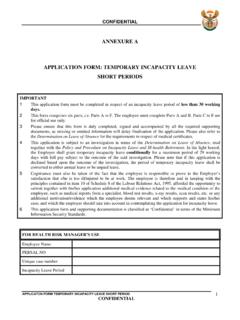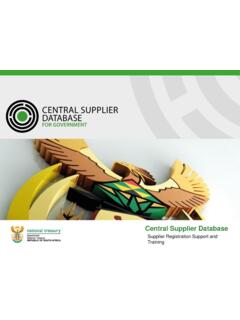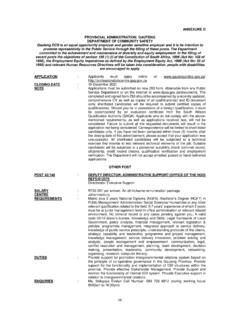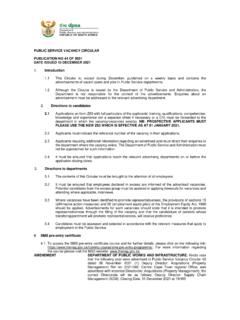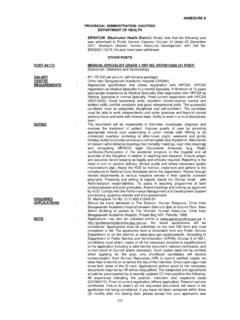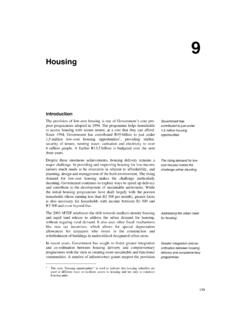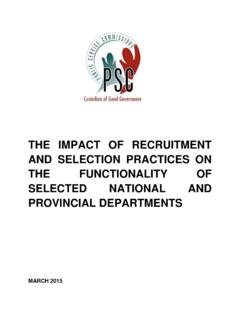Transcription of Provincial and local government - National Treasury
1 937 Provincial and local government In brief The 2014 division of revenue allocates per cent of nationally raised revenue to National departments, per cent to provinces and 9 per cent to municipalities. In addition to large baseline allocations over the medium-term expenditure framework (MTEF) period, further support is provided to roll out new vaccines, expand the antiretroviral programme, upgrade informal settlements, eradicate bucket sanitation, develop more integrated human settlements and fund inflation-linked Provincial wage increases. In line with the goals of the National Development Plan (NDP), government is providing cities with incentives to change the way they plan infrastructure so that developments lead to more integrated, compact and efficient urban environments. Overview rovincial and local governments play critical and complementary roles in eliminating poverty and reducing inequality.
2 Provincial health, education and housing functions support the development of healthy communities, and lay the foundations for faster economic growth. Municipalities deliver basic services such as water, electricity, sanitation and solid waste removal. Both provinces and municipalities manage extensive public road networks, and support or provide public transport services. They also directly manage aspects of planning and regulatory systems that control land use, influence infrastructure rollout and facilitate economic activity. Over the past 20 years, there has been a broad expansion of access to public services. The 2014 Budget allocates per cent of nationally raised resources to provinces and local government , and complements these allocations with measures to improve service-delivery capacity. In addition, provinces and municipalities raise their own revenue, which accounts respectively for 3 per cent and 73 per cent of their total revenue.
3 Provincial and local governments play critical roles in eliminating poverty and reducing inequality P 2014 BUDGET REVIEW 94 The bulk of government s infrastructure spending takes place in local and Provincial government . Public services have not yet reached all South Africans, and in some areas, poor maintenance has resulted in either loss of services or deterioration in quality. Addressing these challenges is a priority in the 2014 Budget. Division of revenue The Constitution requires a division of nationally raised resources between National , Provincial and local government . This is done through the Division of Revenue Bill, which is tabled with the National budget. Over the MTEF period ahead, National department allocations total per cent of available funds after debt costs and the contingency reserve have been provided for, Provincial allocations total per cent and local government allocations total 9 per cent.
4 Provinces are responsible for social services like education, health and social development; economic functions like agriculture and roads; and Provincial governance and administration which include the legislature, Provincial Treasury , local government and human settlements. local government is responsible for water and sanitation, electricity reticulation, refuse removal, storm water management and municipal transport and roads. local government is also responsible for community services (such as parks, sport and recreation, municipal roads and street lighting). To reduce the cost of living for poor households, the provision of free or subsidised services is also paid for by local and Provincial government . Transfers to provinces and local government are made through the equitable share and conditional grants. The equitable shares are determined by formulas that take into account demographic and developmental factors.
5 Conditional grants are designed to achieve specific objectives, and provinces and municipalities must fulfil certain conditions to receive them. The evolution of South Africa s intergovernmental fiscal system South Africa has made important strides in building its intergovernmental fiscal system over the past 20 years. General budget and financial management reforms: Legislation, including the Public Finance Management Act (1999) and Municipal Finance Management Act (2003), modernised public financial management and enhanced transparency and accountability. Budget preparation: government s three-year medium-term expenditure framework (MTEF) provides greater certainty and promotes financial discipline in all three spheres of government . Budget implementation: Once a budget is adopted by the legislature, it becomes a law that all officials are required to implement, with limited opportunity for deviation.
6 Departments are required to report on actual revenue and expenditure on a monthly and quarterly basis. Annual financial statements are audited and, along with monthly and quarterly reports, are available to the public. As with any system that is still maturing, some challenges remain. Concurrent functions: National government s role is to formulate policy, and develop norms and standards; provinces and municipalities are mainly responsible for implementation. In practice the lines of responsibility and accountability are often blurred. These challenges can be overcome through institutional frameworks that allow for greater coordination. Compliance: Gaps are evident in the system, with a high number of adverse audit outcomes, service-delivery failures due to underspending on infrastructure and maintenance, and escalating operating costs due to inadequate controls.
7 Various initiatives are under way to address these gaps, including strengthening National oversight, expenditure reviews and financial management capacity development. Provinces and municipalities receive per cent of the division of revenue CHAPTER 7: Provincial AND local government 95 Table summarises the division of revenue for the 2014 Budget, taking into account the revenue-raising capacities and spending responsibilities of each level of government . In 2012/13, National expenditure amounted to billion (including transfers to provinces and municipalities) out of a total adjusted appropriation of billion. This represents underspending of per cent compared with per cent in 2011/12. Provincial government underspent its adjusted budget of billion for 2012/13 by billion ( per cent), compared with underspending of billion ( per cent) in the previous year.
8 Municipalities spent billion or per cent, of their infrastructure grants in the 2012/13 municipal financial year, up from per cent in 2011/12. The Explanatory Memorandum to the Division of Revenue sets out the Provincial and municipal allocations, details the equitable share formula and explains how the division takes into account the recommendations of the Financial and Fiscal Commission. The memorandum is available as Annexure W1 of the Budget Review on the National Treasury website ( ). Table Division of nationally raised revenue, 2010/11 2016/172010/112011/122012/132013/142014/ 152015/162016/17R millionOutcome Revised estimate Medium-term estimatesDivision of available fundsNational departments356 027 382 712 412 706 449 251 489 424 522 257 552 983 of which: Indirect transfers to provinces 76 860 2 693 5 413 5 044 4 127 Indirect transfers to local government2 939 2 770 4 956 5 697 7 726 9 467 10 221 Provinces322 822 362 488 388 238 414 932 444 423 477 639 508 254 Equitable share265 139 291 736 313 016 338 937 362 468 387 967 412 039 Conditional grants57 682 70 753 75 222 75 995 81 955 89 672 96 215 local government60 904 68 251 76 430 83 670 90 815 100 047 105 187 Equitable share30 541 33 173 37 139 39 789 44 490 50 208 52 869 Conditional grants22 821 26 505 30 251 34 268 36 135 39 181 41 094 General fuel levy sharing withmetropolitan municipalities7 542 8 573 9 040 9 613 10 190
9 10 659 11 224 Non-interest allocations 739 752 813 451 877 374 947 853 1 024 662 1 099 943 1 166 424 Percentage Debt-service costs66 227 76 460 88 121 101 256 114 901 126 647 139 201 Contingency reserve 3 000 6 000 18 000 Main budget expenditure 805 979 889 911 965 496 1 049 109 1 142 562 1 232 590 1 323 624 Percentage Percentage sharesNational spent per cent of their budgets; municipalities spent per cent their infrastructure grants 2014 BUDGET REVIEW 96 Transfers to provinces Provincial departments have limited revenue-raising powers, with 97 per cent of their spending financed through the division of revenue.
10 Provinces account for 97 per cent of total government spending on health, 82 per cent of government spending on education and 11 per cent of government spending on social development. To finance these and other priorities, Provincial governments are allocated per cent of nationally raised revenue in 2014/15. Health, education, and social development services account for over three-quarters of Provincial spending. These are labour-intensive services and as a result, more than 60 per cent of Provincial budgets are spent on compensation of employees. Reducing costs and increasing value for money During 2013, the National Treasury and its Provincial counterparts conducted joint expenditure reviews. The reviews identified areas where inefficient operations can be improved to increase value for money and ensure spending on policy priorities. The review process has shown that: Efficiencies in the supply of learning and teaching support materials vary widely, underlining the need to adopt best practice across all provinces.










